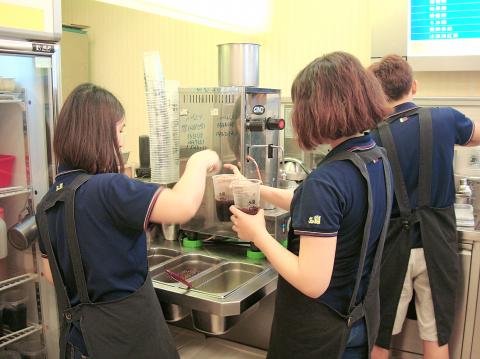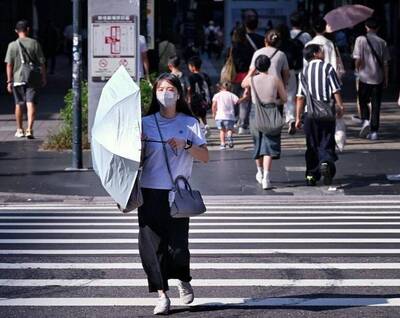Aletheia University said it hopes its application for radio frequency identification (RFID) technology can help alleviate consumer concern over hand-shaken soft drinks, following revelations some chain stores are using mixed tea leaves.
According to school of management professor Hong Chao-fu (洪朝富), there is no question concerning the quality of Taiwanese tea leaves, but the profit made using mixed leaves is too great.
Vietnamese-grown tea leaves cost NT$100 per kilogram, while Taiwanese tea leaves cost NT$3,000 per kilogram, Hong said, adding that mixed leaves have become common due to a lack of certification measures.

Photo courtesy of the Department of Health
Hong said it was during a conversation with an alumnus of the school that the third-party certification concept came into being.
The concept entails using cameras to capture the processing procedure of tea leaves, then uploading the footage to a cloud server, Hong said.
Tea factories working with the project could later put an RFID tag on tea packaging, allowing consumers to access the stored data on the cloud server via the Near Field Communication (NFC) system on smart phones, Hong said.
Tea factories were reluctant to cooperate with the project due to the “secret touch” each factory uses to handle their tea leaves, Hong said, adding that they persuaded owners to try the project as the cameras are set on wide-angle view.
It would be close enough to capture the process of making and packaging tea leaves, but not close enough to capture the secrets of the factories, Hong said.
It took at two days, of ceaseless filming to record an entire process.
Hong said he believed that only by recording an entirely transparent packaging process would the project become credible, adding that he hoped the government would take over the project as it would be more credible.
Chen Ping-kuo (陳屏國), another member of the project said, the RFID tag would include algorithms that would prevent hacking or faking data by asking for confirmation with the cloud server.
Since the tags are linked directly to cloud servers and the team has established a center to monitor all information, any fake data would not show up when the consumer scans the tag, Chen said.
Chen said that compared with QR codes, RFID tags are able to carry more data and are less likely to be forged, adding that the tags would allow a better degree of protection for the quality of Taiwanese tea leaves.
“The project aims to increase the value of Taiwanese tea leaves by at least 20 percent as well as attempting to eradicate the problem of tea factories attempting to mix leaves to maximize profit,” Hong said.
Hong added that the project would also seek to induct students and allow them to gain some practical experience.
Students that have selected courses in practical implementation of e-commerce and the digitization of businesses would be able to participate in the project and visit the tea factories, Hong said.
The project would also induct students from the department of Taiwanese literature in hopes of increasing the project’s cultural creativity, Hong said.
“The project might help the Taiwanese tea industry to pull out from the shadows cast by food security,” he said, adding that the technology could also be used in the production of coffee beans and other produce.

Foreign travelers entering Taiwan on a short layover via Taiwan Taoyuan International Airport are receiving NT$600 gift vouchers from yesterday, the Tourism Administration said, adding that it hopes the incentive would boost tourism consumption at the airport. The program, which allows travelers holding non-Taiwan passports who enter the country during a layover of up to 24 hours to claim a voucher, aims to promote attractions at the airport, the agency said in a statement on Friday. To participate, travelers must sign up on the campaign Web site, the agency said. They can then present their passport and boarding pass for their connecting international

Temperatures in northern Taiwan are forecast to reach as high as 30°C today, as an ongoing northeasterly seasonal wind system weakens, the Central Weather Administration (CWA) said. CWA forecaster Tseng Chao-cheng (曾昭誠) said yesterday that with the seasonal wind system weakening, warmer easterly winds would boost the temperature today. Daytime temperatures in northern Taiwan and Yilan County are expected to range from 28°C to 30°C today, up about 3°C from yesterday, Tseng said. According to the CWA, temperature highs in central and southern Taiwan could stay stable. However, the weather is expected to turn cooler starting tonight as the northeasterly wind system strengthens again

COOLING OFF: Temperatures are expected to fall to lows of about 20°C on Sunday and possibly 18°C to 19°C next week, following a wave of northeasterly winds on Friday The Central Weather Administration (CWA) on Sunday forecast more rain and cooler temperatures for northern Taiwan this week, with the mercury dropping to lows of 18°C, as another wave of northeasterly winds sweeps across the country. The current northeasterly winds would continue to affect Taiwan through today, with precipitation peaking today, bringing increased rainfall to windward areas, CWA forecaster Liu Pei-teng (劉沛滕) said. The weather system would weaken slightly tomorrow before another, stronger wave arrives on Friday, lasting into next week, Liu said. From yesterday to today, northern Taiwan can expect cool, wet weather, with lows of 22°C to 23°C in most areas,

Taiwan sweltered through its hottest October on record, the Central Weather Administration (CWA) said yesterday, the latest in a string of global temperature records. The main island endured its highest average temperature since 1950, CWA forecaster Liu Pei-teng said. Temperatures the world over have soared in recent years as human-induced climate change contributes to ever more erratic weather patterns. Taiwan’s average temperature was 27.381°C as of Thursday, Liu said. Liu said the average could slip 0.1°C by the end of yesterday, but it would still be higher than the previous record of 27.009°C in 2016. "The temperature only started lowering around Oct. 18 or 19